Did you know that Angkor Wat in Cambodia is the largest religious monument in the world but didn't make the new list of Seven Wonders of the World? Or that it is actually rented for a profit to an entity outside of Cambodia? A few of these 20 Angkor Wat facts may surprise you.
Angkor Wat, Cambodia's famous UNESCO World Heritage Site, is breathtaking and thrilling to explore. The temple ruins have a way of igniting the inner archaeologist in all of us. You won't soon forget wandering the sprawling, carved ruins of a once-great civilization!
Fact #1
Angkor Wat is the primary reason that more than 50% of international tourists visit Cambodia each year. Cambodians are proud of their ancient monument, so proud that they put it on the Cambodian flag in 1850.
The only other country flag in the world that features a national monument is the current flag of Afghanistan. Images from Angkor Wat also appear on many denominations of the riel (Cambodia's currency).

Fact #2
Constructed in the early 12th century (between 1113 and 1150), Angkor Wat is considered to be the largest religious monument in the world. But in this instance, size didn't matter: Cambodia still didn't make the cut as one of the New Seven Wonders of the World elected by vote on July 7, 2007.
Fact #3
Angkor Wat is unusually oriented to the west, a direction typically associated with death in Hindu culture. Archaeologists and scholars disagree as to why the ancient builders chose to deviate from the norm (pointing structures east) at the time.
Fact #4
Bas-reliefs at Angkor Wat read counterclockwise, another indication that the temple is associated with funeral rituals.
Fact #5
Also unusual for the time of construction, Angkor Wat was dedicated to Vishnu, a Hindu deity, rather than the current king.
Fact #6
Angkor Wat was shifted from Hindu to Buddhist use sometime around the late 13th century. The temple is still used by Buddhists as a place of worship today.

Fact #7
Jacqueline Kennedy risked a visit to Angkor Wat during the Vietnam War to fulfill a "lifelong dream" of seeing the monument.
Fact #8
Angkor Wat translates to "City of Temples" or simply "City Temple." New temples and ruins are being discovered nearly every year.

Fact #9
Henri Mouhot, a French explorer, helped bring Angkor Wat to fame in the West by publishing an account of his visit in the mid-19th century. His book is Travels in Siam, Cambodia, Laos, and Annam.
Fact #10
The Angkor ruins stretch over more than 248 square miles (400 square kilometers). Many visitors mistaken the size of Angkor and visit only a few of the most famous temples.
Fact #11
The sandstone used to construct Cambodia's national monument, at least 5 million tons worth, had to be carried from a quarry 25 miles away.
Fact #12
Angkor Wat was made a UNESCO World Heritage Site in 1992. The site suffered from decades of unregulated tourism and looting; many ancient statues have been decapitated and their heads sold to private collectors. An international collaborative effort has helped to slowly restore sites and prevent further collapse of unstable structures.
Fact #13
Sokimex, a private company founded by an ethnic Vietnamese-Cambodian businessman, has rented Angkor Wat from Cambodia since 1990 and manages tourism there -- for profit. Sokimex also has a petroleum division, manages hotels, and runs Sarika Air Services.
Fact #14
Most of the money to restore Angkor Wat comes from foreign aid. Only an estimated 28% of ticket sales goes back into the temples.
Fact #15
A three-day pass to explore the Angkor temples costs US $40. A single-day pass is available for US $20, or a week-long pass can be purchased for US $60.
Fact #16
One of the first Westerners to see Angkor Wat was Antonio da Madalena, a Portuguese monk, who visited in 1586. Long before Europeans arrived, a Chinese emissary named Zhou Daguan lived in Angkor for one year between 1296 and 1297; he created a written account of his experience there sometime before 1312. Zhou Daguan's book, the only account of 13th-century Angkor, was translated into English by Peter Harris in the book A Record of Cambodia.
Fact #17
The Angkor temple Ta Prohm -- famous for the large vines that strangle the ruins -- was used as the set for the hit movie Tomb Raider. Paramount was charged US $10,000 per day for seven days to film there. Unfortunately, some of the iconic trees growing through the ruins at Ta Prohm have had to be removed to preserve the temple from further collapse.

Fact #18
The original outer wall at Angkor Wat once enclosed the temple proper, city, and royal palace, occupying a space of 203 acres (820,000 square meters). Nothing remains of the wall today.
Fact #19
Khmer bricks were bonded together almost invisibly by using a vegetable compound rather than mortar.
Fact #20
Many visitors do not realize that many surfaces of the Angkor temples were once painted. Today, only small traces of the paint remains on just a few temples.



















